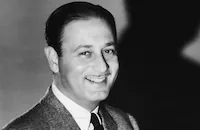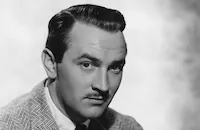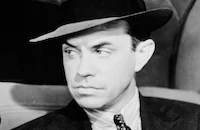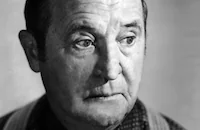Society Lawyer

Brief Synopsis
Cast & Crew
Edwin L. Marin
Walter Pidgeon
Virginia Bruce
Leo Carrillo
Eduardo Ciannelli
Lee Bowman
Film Details
Technical Specs

Synopsis
Socialite Sue Leonard thinks that her fiancé, society lawyer Christopher Durant, should stop defending gangsters such as Tony Gazotti, whom he has just gotten acquitted on a murder charge. That opinion is shared by Chris's conservative law firm, headed by Sue's father, who reluctantly asks Chris to resign. Sue breaks her engagement to Chris, who graciously gives his blessing to her relationship with their mutual friend, Phil Siddall. Phil then severes his ties to Judy Barton, angering Judy enough to threaten him and call her old boyfriend, gangster Jim Crelliman. Crelliman is still angry with Judy for throwing him over for Phil, but pretends that he still cares for her. After she arrives at a party at Crelliman's apartment, he insists that she publicly tell Phil, whom he has also invited to the party, they are through. At the party, Crelliman asks them to go out on the terrace, and while he is dancing with someone else, shots are heard, and Phil is discovered standing over Judy's body with a revolver. The next morning, Sue asks Chris's help to defend Phil, and he agrees. Despite the evidence, Chris believes in Phil's innocence and asks Tony, who is Crelliman's rival, for help. Tony then introduces Chris to Pat Abbott, a singer in Tony's nightclub, who was Judy's friend and upstairs neighbor. She agrees to help Chris and stay at his apartment until the case is settled. When police Lieutenant Stevens, a friend of Chris, shows him photos of Judy's body, he is convinced that she could not have been shot by Phil, but by someone from above the terrace. By accident, Pat reveals that Judy used to pawn things with a man named Frederick Schmidt, who is a friend of Crelliman's and the same man who swore that Phil bought the murder weapon from him. After questioning Schmidt, Chris learns from Tony that Schmidt has just been murdered. Searching for clues in Pat's apartment, which overlooks the terrace where Judy was killed, Chris is interrupted by Crelliman, who threatens Chris, then draws a gun. Chris overpowers him and escapes, then enters the apartment of Crelliman's henchman, Tim Murtock, with a passkey provided by Tony, and discovers that it has the exact angle from which Judy was shot. With the aid of the elevator operator, Chris gets away from the building and is found by Tony, who tells him the name of the bar where Murtock is. Seeing Pat leave the bar with Murtock, Chris becomes angry, then summons Stevens to Crelliman's apartment. When Pat arrives, she tells him that she lured Murtock away from his apartment for Chris's protection and Chris realizes that he has fallen in love with her. He then asks Pat to go to Crelliman's and get him onto the terrace, while Chris takes Stevens to Murtock's apartment to observe. By pretending to be working on a frame-up of his own, Chris gets a confession out of Murtock, who admits that he shot Judy for Crelliman. Now seeing that Pat is in danger, Chris and the police go to Crelliman's apartment and find that Tony shot Crelliman to save Pat and was mortally wounded himself. Back at Chris's, his butler Layton eavesdrops on a call from Sue and tells Pat that Chris is going to marry her and take them all to Europe.

Director

Edwin L. Marin
Cast

Walter Pidgeon

Virginia Bruce

Leo Carrillo

Eduardo Ciannelli

Lee Bowman

Frances Mercer

Ann Morriss

Herbert Mundin
Frank M. Thomas

Edward S. Brophy

Tom Kennedy

Clarence Kolb

Pierre Watkin

Ian Wolfe

Paul Guilfoyle

Joseph Crehan
Lillian Yarbo
Selmer Jackson

James Millican
Jack Gardner
Ferris Taylor

Bess Flowers

Frank Orth
Lester Dorr
Gordon Hart

Frank Puglia
Frank Sully
Charles Regan
Sherry Hall
Harry Humphrey
Joe Whitehead
Robert Fiske
Lillian Elliott
Ethelreda Leopold
Brick Sullivan
Jack Daley
Don Brodie
Eric Wilton
Drew Demorest
Harrison Greene
Sharon Lewis
Jenifer Gray
Harry Strang
Harry Fleischman

Howard Mitchell
Anthony Warde
Crew
Leo Arnaud
Hugo Butler
Howard Campbell
John W. Considine Jr.
Sam Coslow
Roger Edens
George Folsey
Cedric Gibbons
Frances Goodrich
Leon Gordon
Dick Green
Albert Hackett
Louis D. Lighton
Howard O'neill
Douglas Shearer
Georgie Stoll
Dolly Tree
Edward Ward
Edwin B. Willis

Film Details
Technical Specs

Articles
Society Lawyer
Tagline for Society Lawyer
Although her career had started to lag with the death of Irving G. Thalberg, her main champion at MGM, Virginia Bruce still merited some level of star treatment, even in a B picture like this 1939 crime drama. Although it takes her character, nightclub singer Pat Abbott, a while to turn up on screen as love interest to Walter Pidgeon, in the title role, at least she got to sing "I'm in Love with the Honorable So and So" with some welcome coaching from the film's music director, Roger Edens.
If Bruce was on her way out, however, Pidgeon was gradually building his stock at MGM, where he had started out in 1937 after a few years at other studios and a strong career on stage. He stars as lawyer Christopher Durant, who loses his fiancée and his position at her father's law firm because he insists on representing gangster Leo Carrillo. When his ex's new boyfriend (Lee Bowman) is accused of killing an old flame, he takes on the case. That puts him in contact with Bruce, who was the victim's friend. Before long, she's made herself an indispensable part of the investigation and of Pidgeon's life, though not without some risk to herself.
This was hardly a new plot for MGM. Although the writing credits only list the screenplay as taken from a story by Arthur Somers Roche, it was actually adapted from his novel Penthouse, which MGM had filmed in 1933 with Warner Baxter as the lawyer and Myrna Loy as his love interest. The husband and wife writing team of Frances Goodrich and Albert Hackett had written the earlier version. Although there are no studio records of their having worked on the re-make, they are credited as screenwriters alongside Leon Gordon and Hugo Butler, possibly to give them credit without publicizing the fact that the film was a remake. Nonetheless, there are scenes and lines of dialogue in Society Lawyer that are identical to those in Penthouse.
One of the great selling points of Society Lawyer is its supporting cast. Carrillo, best remembered for playing lovable scamps in films like The Gay Desperado (1936) and History Is Made at Night (1937), co-stars as the friendly gangster who helps Pidgeon solve the case in return for his legal services. The evil gangster is handled by one of the screen's great villains, Eduardo Ciannelli, who had provided sophisticated menace in the film version of Maxwell Anderson's verse tragedy Winterset (1936) and, most recently, menaced Cary Grant and Douglas Fairbanks, Jr. in Gunga Din (1939). Stealing almost every scene he's in is Herbert Mundin as Pidgeon's butler. The British-born actor had been lighting up screens since his feature debut in East Lynne on the Western Front (1931), in which he had played a British soldier in the trenches during World War I who takes on the role of Lady Isobel in an impromptu production of the classic melodrama East Lynne. He was Barkis in MGM's David Copperfield (1935) and the member of the Merrie Men in The Adventures of Robin Hood (1938) who flirts with Maid Marian's lady in waiting (Una O'Connor). Sadly, Society Lawyer would be his last film. He was killed in an automobile collision a few weeks before the film's release.
It was near the end of the road for Bruce, too. She would only make one more film at MGM, this time top-billed over Pidgeon in the courtroom drama Stronger Than Desire (1939). That film also features Bowman, this time as a married man trying to lure Bruce away from husband Pidgeon. The latter would be moving on to brighter things in just two years, when MGM teamed him with Greer Garson for Blossoms in the Dust (1941), the first of eight films together that would make both major stars.
Director: Edwin L. Marin
Producer: John W. Considine, Jr.
Screenplay: Frances Goodrich, Albert Hackett, Leon Gordon, Hugo Butler
Based on a story by Arthur Somers Roche and his novel Penthouse
Cinematography: George J. Folsey
Score: Edward Ward
Cast: Walter Pidgeon (Christopher Durant), Virginia Bruce (Pat Abbott), Leo Carrillo (Tony Gazotti), Eduardo Ciannelli (Jim Crelliman), Lee Bowman (Phil Siddall), Frances Mercer (Sue Leonard), Ann Morriss (Judy Barton), Herbert Mundin (Layton), Edward Brophy (Max), Tom Kennedy (Alf), Clarence Kolb (Mr. Leonard), Ian Wolfe (Schmidt), Paul Guilfoyle (Murtock), Joseph Crehan (City Editor), Bess Flowers (Mary Trimworth), Frank Puglia (Headwaiter)
By Frank Miller

Society Lawyer
Quotes
Trivia
Anthony Warde is in studio records for acting in this movie, but he was not seen in the viewed print.
A plagiarism suit was filed by Robert Brister and Harry T. Bliven against the use of the title, but it was dismissed by the court.
Notes
Working titles for this film were Penthouse and Night in Manhattan. Arthur Somer Roche's novel also appeared as a serial in Hearst's International-Cosmopolitan (publication date undetermined). According to a Hollywood Reporter pre-production news item, Melvyn Douglas was originally slated to star opposite Virginia Bruce. Society Lawyer was actor Herbert Mundin's last film before his death in 1939. A March 1939 Hollywood Reporter news item notes that a plagiarism suit filed by Robert Brister and Harry T. Bliven against M-G-M for use of the title was dismissed on March 6, 1939. The picture was a remake of the 1933 M-G-M film Penthouse. Frances Goodrich and Albert Hackett, who wrote the screenplay for the 1933 film, received co-writing credit with Leon Gordon and Hugo Butler. Although Goodrich and Hacket were still working at M-G-M in 1939, it is probable that their contribution to Society Lawyer was solely the work they did on Penthouse. Many scenes and lines of dialogue in the two films are identical.















